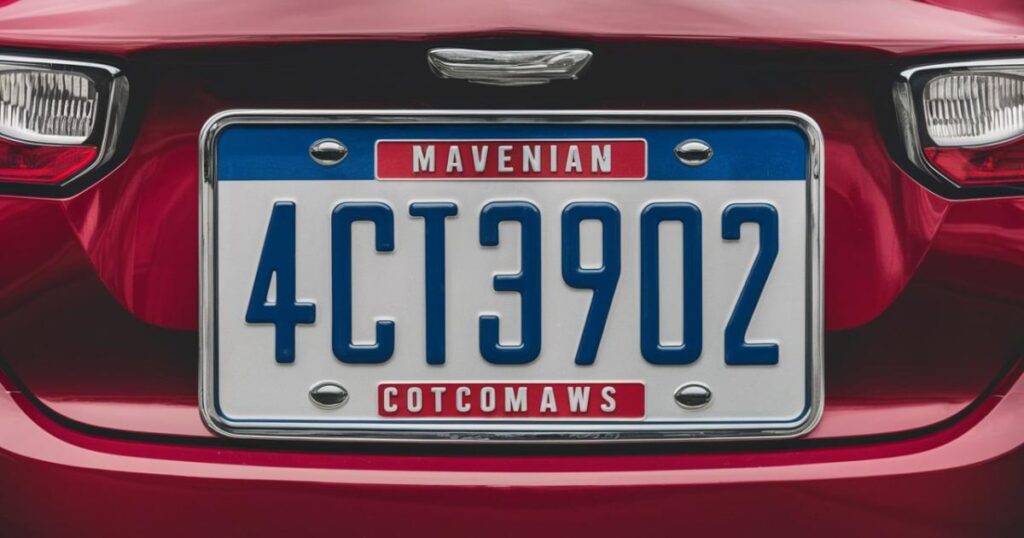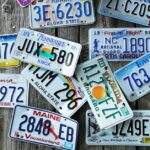Have you ever noticed the letters “PM” on license plates and wondered what they mean? If so, you’re not alone. This simple two-letter code is a common sight on the roads, but its meaning is a mystery to many drivers. In this comprehensive guide, we’ll dive deep into the world of license plate markings and uncover the truth behind the enigmatic “PM” symbol.
While it may seem like a minor detail, the “PM” designation on a license plate carries a lot of weight. It’s a crucial identifier that communicates important information about a vehicle’s registration status. By understanding what it means, you’ll be able to avoid potential citations or fines for expired registration, quickly assess whether a vehicle is legally permitted on the road, and gain insight into the state’s registration renewal process.
Breaking Down the Code
At its core, the “PM” marking is a simple abbreviation – but for what? Let’s break it down:
- The “P” stands for “Period,” referring to the timeframe in which a vehicle’s registration is valid.
- The “M” represents “Months,” specifically the months of September through December.
- Together, they indicate that the vehicle’s registration is valid from September through the end of the following year.
For example, if you see a license plate with “PM” on it in October 2023, it means that the registration is current and will remain valid until December 31, 2024. This simple code serves as a visual cue, allowing law enforcement officers and other drivers to quickly determine the compliance status of a vehicle without needing to reference specific dates.
It’s important to note that the “PM” designation is not universal across all states. Some states may use different codes or abbreviations to indicate registration periods, such as “EXP” for expiration or “REN” for renewal. However, in many states, particularly those with larger populations like California, Texas, and Florida, “PM” is the standard code used to signify a vehicle’s registration validity from September through December.
How to Get a “PM” License Plate
Now that you know what “PM” means, you might be wondering how to get a plate with this designation. Fear not! We’ll walk you through the process step-by-step:
- Determine your state’s renewal period: Most states, including Florida, Texas, and California, offer a “PM” renewal window from September 1st through December 31st each year.
- Gather the required documents: Typically, you’ll need to provide proof of insurance, a completed renewal form, and payment for the applicable fees. Some states may also require an emissions test or safety inspection report.
- Visit your local DMV office or renew online: Many states allow you to renew your registration in person at a DMV branch or through their online portal. Online renewal can be a convenient option, allowing you to skip the lines and complete the process from the comfort of your home or office.
- Pay the applicable fees: Registration renewal fees vary by state and vehicle type but generally range from $50 to $100 annually. Some states may offer discounts for early renewal or multi-year registration options.
Once you’ve completed the renewal process and paid the required fees, your new license plate featuring the “PM” code will be issued and mailed to you, or you can pick it up at the DMV office.
Insider Tips and Tricks
To make the renewal process even smoother, keep these insider tips in mind:
- Avoid the last-minute rush: Renewing early in the “PM” window can help you skip long lines and potential delays. Many drivers wait until the last minute, leading to overcrowded DMV offices and extended wait times.
- Consider online renewal: Many states offer online renewal options, which can save you time and effort. Just be sure to have all the required documents and information on hand before starting the process.
- Watch for grace periods: Some states provide a short grace period after your expiration date, but it’s best to renew on time to avoid late fees or potential citations. Grace periods are typically only a few days or weeks and should not be relied upon for timely renewal.
- Explore multi-year options: If your state offers it, consider renewing for multiple years at once. This can save you money in the long run and eliminate the need for annual renewals.
By following these tips, you can streamline the “PM” license plate renewal process and ensure a hassle-free experience.
Also More Post:
What Does F P Stand For On Illinois License Plates?
Decoding Other License Plate Markings
While “PM” is a common sight, it’s just one piece of the license plate puzzle. Many other codes, symbols, and abbreviations can be found on plates across the country. Let’s explore a few:
- “DV” for disabled veterans
- Numeric prefixes for fleet vehicles (e.g., “2” for government-owned vehicles)
- Symbols for special registrations (organ donors, firefighters, etc.)
For example, a plate with “DV” followed by a unique number sequence indicates that the vehicle is registered to a disabled veteran and may be eligible for certain benefits or privileges, such as free parking or toll exemptions.
Similarly, a plate with a “2” prefix followed by a code typically signifies that the vehicle is owned and operated by a government agency, such as a city or county. These vehicles are often used for official business or maintenance purposes.
Some states also incorporate unique symbols or designs on their license plates to indicate special registrations. For instance, a heart symbol may signify that the vehicle owner is an organ donor, while a firefighter’s badge or Maltese cross could represent a registered firefighter or emergency responder.
The Importance of Plate Literacy
Understanding license plate markings isn’t just a matter of curiosity – it’s a crucial skill for navigating the roads safely and legally. By becoming “plate literate,” you can:
- Easily identify vehicles with expired or invalid registrations
- Recognize special plates and show respect/courtesy accordingly
- Contribute to a well-informed driving community
Imagine you’re driving down the highway and notice a vehicle with an expired registration sticker. By being able to quickly identify this, you can exercise caution and maintain a safe distance, potentially avoiding a dangerous situation involving an uninsured or unlawful driver.
Additionally, being aware of special plates like those for disabled veterans or emergency responders can help you extend common courtesies, such as yielding the right-of-way or providing extra space on the road.
By fostering a community of “plate literate” drivers, we can all play a role in promoting safer and more responsible driving practices.
The Evolution of License Plate Design
License plates have come a long way since their inception. In this section, we’ll take a brief look at how plate design and coding systems have evolved over time:
- Early plate styles and materials: Initial license plates were often made of metal or leather and featured simple number or letter combinations. These early plates were primarily intended for basic identification and record-keeping purposes.
- The rise of standardized formats: As vehicle ownership increased in the early 20th century, states adopted more consistent plate formats and codes for easier identification and tracking. This helped establish a common language for license plates across different jurisdictions.
- Technological advancements: Today, many states are exploring digital license plates, RFID chips, and other technologies to enhance vehicle identification and database integration. These innovations aim to streamline processes like toll collection, parking management, and law enforcement efforts.

Evolution of license plate designs, from early metal plates to modern digital options.
One notable example of design evolution is the transition from embossed or stamped metal plates to flat, printed plates. This change not only improved readability but also allowed for the incorporation of more intricate designs, colors, and graphics onto license plates.
Additionally, many states have embraced the use of specialty or vanity plates, which allow drivers to personalize their plates with unique number and letter combinations, often for an additional fee. These custom plates have become a popular way for drivers to express their individuality while still adhering to registration and identification requirements.
The Future of Vehicle Identification
As technology continues to advance, so too will the systems we use to identify and track vehicles. Here are a few potential changes on the horizon:
- Digital license plates: These plates could display dynamic information, such as registration expiration dates, and even integrate with smart city infrastructure.
- AI-powered recognition: Advanced AI systems may be able to instantly recognize and cross-reference license plates with databases, streamlining enforcement and record-keeping.
- Privacy and security concerns: As vehicle identification becomes more sophisticated, there will be ongoing discussions around balancing innovation with privacy rights and data security.
What are your thoughts on the future of vehicle identification? Share your ideas and predictions in the comments below!
Final Thoughts/Conclusion
By now, you should have a comprehensive understanding of what “PM” means on a license plate, as well as the broader world of vehicle registration markings. Armed with this knowledge, you’ll be able to navigate the roads with confidence, avoid costly mistakes, and appreciate the intricate systems that keep our transportation networks running smoothly.
Remember, being an informed and responsible driver isn’t just about following the rules of the road – it’s about understanding the language of license plates and using that knowledge to create a safer, more efficient driving experience for all.
Frequently Asked Questions
Can you get a permanent tag in Florida?
In Florida, you can get personalized license plates that stay with you when you renew your vehicle registration every year. There is an initial fee to get a personalized plate.
What does PP mean on a license plate in California?
On a California license plate, “PP” stands for Passenger Plate, which is the normal passenger vehicle license plate type issued in California.
What Does FP Mean On An Illinois License Plate?
On an Illinois license plate, “FP” means Fleet Plate, which is a special plate issued to companies or organizations that have multiple vehicles in their fleet.
Is there an extra cost for “PM” license plates?
In some states like Florida, there is an extra annual cost to renew a “PM” or personalized license plate above the normal registration renewal fee.
How long is a “PM” license plate valid?
A “PM” or personalized license plate is usually valid for as long as you hold the vehicle registration and pay the periodic renewal fees, which can range from 1 to 2 years depending on the state.



